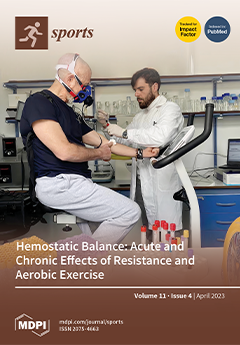We examined the relationship between football-specific training and changes in bone structural properties across a 12-week period in 15 male football players aged 16 years (Mean ± 1 SD = 16.6 ± 0.3 years) that belonged to a professional football academy. Tibial scans were performed at 4%, 14% and 38% sites using peripheral quantitative computed tomography immediately before and 12 weeks after increased football-specific training. Training was analysed using GPS to quantify peak speed, average speed, total distance and high-speed distance. Analyses were conducted with bias-corrected and accelerated bootstrapped 95% confidence intervals (BCa 95% CI). There were increases in bone mass at the 4% (mean ∆ = 0.15 g, BCa 95% CI = 0.07, 0.26 g,
g = 0.72), 14% (mean ∆ = 0.04 g, BCa 95% CI = 0.02, 0.06 g,
g = 1.20), and 38% sites (mean ∆ = 0.03 g, BCa 95% CI = 0.01, 0.05 g,
g = 0.61). There were increases in trabecular density (4%), (mean ∆ = 3.57 mg·cm
−3, BCa 95% CI = 0.38, 7.05 mg·cm
−3,
g = 0.53), cortical dentsity (14%) (mean ∆ = 5.08 mg·cm
−3, BCa 95% CI = 0.19, 9.92 mg·cm
−3,
g = 0.49), and cortical density (38%) (mean ∆ = 6.32 mg·cm
−3, BCa 95% CI = 4.31, 8.90 mg·cm
−3,
g = 1.22). Polar stress strain index (mean ∆ = 50.56 mm
3, BCa 95% CI = 10.52, 109.95 mm
3,
g = 0.41), cortical area (mean ∆ = 2.12 mm
2, BCa 95% CI = 0.09, 4.37 mm
2,
g = 0.48) and thickness (mean ∆ = 0.06 mm, BCa 95% CI = 0.01, 0.13 mm,
g = 0.45) increased at the 38% site. Correlations revealed positive relationships between total distance and increased cortical density (38%) (r = 0.39, BCa 95% CI = 0.02, 0.66), and between peak speed and increased trabecular density (4%) (r = 0.43, BCa 95% CI = 0.03, 0.73). There were negative correlations between total (r = −0.21, BCa 95% CI = −0.65, −0.12) and high-speed distance (r = −0.29, BCa 95% CI = −0.57, −0.24) with increased polar stress strain index (38%). Results suggest that despite football training relating to increases in bone characteristics in male academy footballers, the specific training variables promoting adaptation over a 12-week period may vary. Further studies conducted over a longer period are required to fully elucidate the time-course of how certain football-specific training characteristics influence bone structural properties.
Full article






